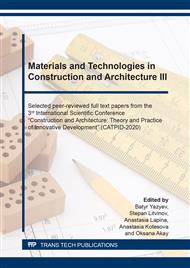p.123
p.130
p.136
p.144
p.151
p.158
p.164
p.171
p.179
Frame Polymerbetons Based on Fillers of Different Nature
Abstract:
Recently, the frame composite materials have been developed greatly at the production introduction level. The manufacturing technology of these materials is carried out in two stages: first, large aggregates are glued into the frame, and second, the porous frame voids are impregnated with the matrix component. In this article, we studied the various aggregates’ effect on the polymer concrete frame structures properties using epoxy binders. The materials based on the quenched cullet, brickbats, granite and limestone crushed stone, and the polymer granules were considered as large aggregates. The studied properties were the strength and elastic modulus. Quantitative dependences of compressive and bending strength, elastic modulus of frame composites on the aggregate type and other prescription factors are obtained. Using the methods of mathematical experimental planning, the optimal particle size distribution for the composites with grains from quenched cullet was selected. Particular attention should be paid to the possibility of using industrial wastes in polymer concrete compositions: polymer granules, quenched cullet and brickbats. Used glass makes up about 10% of the household waste. Its reuse is usually associated with high capital costs allocated for sorting glass by color, removing stones and other impurities. Glass grinding allows to get a fine-grained filler and aggregate. Strength and deformation characteristics of the matrix compositions, frameworks and composites as a whole are determined.
Info:
Periodical:
Pages:
164-170
Citation:
Online since:
September 2020
Authors:
Price:
Сopyright:
© 2020 Trans Tech Publications Ltd. All Rights Reserved
Share:
Citation:


